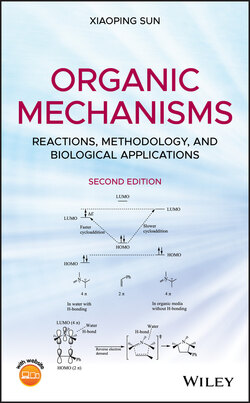Читать книгу Organic Mechanisms - Xiaoping Sun - Страница 19
Bimolecular reactions
ОглавлениеA bimolecular reaction that involves two reactant molecules of the same compound (Eq. 1.4: 2A ➔ P) follows the second‐order rate law as shown below:
(1.14)
where k is the rate constant (with the typical unit of M−1s−1) for the reaction.
Rearranging Equation 1.14 leads to
(1.15)
Integrating Equation 1.15 on both sides and applying the boundary condition t = 0, [A] = [A]0 (initial concentration), we have
(1.16)
From Equation 1.16, we have
(1.17)
Equation 1.17 is the integrated rate law for a bimolecular reaction involving two molecules from the same compound.
A bimolecular reaction that involves two reactant molecules of different compounds (Eq. 1.5: A + B ➔ P) also follows the second‐order rate law (first‐order in each of the reactants) as shown in Equation 1.18.
(1.18)
Assume that at a given time t, the molar concentration of the product P is x. Therefore, the molar concentrations of reactants A and B are [A] = [A]0 − x and [B] = [B]0 − x, respectively. [A]0 and [B]0 are initial concentrations of reactants A and B, respectively.
From Equation 1.18, we have
(1.19)
If the quantities of the two reactants A and B are in stoichiometric ratio ([A] 0 = [B]0), Equation 1.19 becomes
(1.20)
Rearranging Equation 1.20 leads to Equation 1.21.
(1.21)
Integrating Equation 1.21 on both sides and applying the boundary condition t = 0, x = 0, we have
(1.22)
From Equation 1.22, we have
(1.23)
Since [A] = [A]0 − x, Equation 1.23 becomes
If the reactants A and B have different initial concentrations, Equation 1.19 becomes
(1.24)
Integrating Equation 1.24 on both sides and applying the boundary condition t = 0, x = 0, we have
(1.25)
From Equation 1.25, we have
(1.26)
Since [A] = [A]0 − x and [B] = [B]0 − x, Equation 1.26 becomes
(1.27)
Equation 1.27 represents the integrated rate law for a bimolecular reaction involving two different reactant molecules with different initial concentrations.
If one of the reactants (such as B) in Equation 1.5 (the bimolecular reaction: A + B ➔ P) is in large excess (typically 10–20‐folds, i.e., [B]0/[A]0 = 10–20), the change in molar concentration of reactant B in the course of the reaction can be neglected ([B] ~ [B]0) [2]. The rate law (Eq. 1.18) becomes
Let k′ = k[B]0 (the observed rate constant). We have
The reaction becomes pseudo first order. The integrated rate law is
